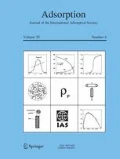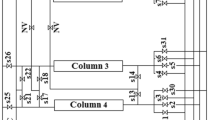Abstract
Small scale processing of flue gas with the goal of enriching the stream in CO2 for sequestration or use is an interesting application area for adsorption technology. For example, boiler flue gas which may contain up to 10 % (v/v) CO2 in air can be readily enriched to a stream containing >70 % CO2 which may be ideal for use within a process such as acidification, precipitation, stripping, etc. The challenge in these applications is producing high purity CO2 without excessive energy use and handling high concentrations of water vapor without the added complication of a pre-drying stage. In this study we have examined the use of microwave assisted vacuum as a way of rapidly directing thermal energy to the adsorbent surface to liberate water and CO2. Preliminary “proof-of-concept” pump down experiments were conducted on a small transparent adsorption column of 13X zeolite pre-saturated with a 12 % CO2 in N2 gas mixture. Both wet and dry gas tests were conducted. The addition of microwave radiation improved the rapid desorption of CO2 and water and improved the integrated CO2 purity in the blowdown stream from 60 to 80 %. In the case of dry CO2 mixtures, the enhancement is due to microwave heating of the 13X zeolite facilitated by the high cation density in the faujasite structure. In the case of water and CO2 desorption, the temperature rise of the adsorbent upon microwave heating was much lower than that predicted by simple heating suggesting that the microwave radiation is absorbed primarily by the adsorbed water. A simplified energy analysis suggests that brief exposure of an adsorbent to microwave radiation will raise the required vacuum level for regeneration of high humidity flue gas streams and may lead to an overall lower energy penalty. The selective ability of microwave radiation to target different species provides scope for optimized, compact, flue gas treatment systems.








Similar content being viewed by others
Abbreviations
- C :
-
Total gas concentration (mol/cm3)
- C i :
-
Concentration of species i (mol/cm3)
- t :
-
Time (s)
- \(\varepsilon_{b}\) :
-
Bed voidage
- \(\rho_{\text{ads}}\) :
-
Adsorbent density (g/cm3)
- \(\bar{n}_{i}\) :
-
Loading of component i (mol/g)
- \(\bar{n}_{T}\) :
-
Total loading (mol/g)
- \(\bar{n}_{i}^{*}\) :
-
Equilibrium loading of component i (mol/g)
- u :
-
Gas interstitial velocity (cm/s)
- z :
-
Axial distance (cm)
- k i :
-
Linear driving force constant (1/s)
- D eff :
-
Effective diffusion coefficient for i in the adsorbent (cm2/s)
- R p :
-
Pellet radius (cm)
- C p, ads :
-
Adsorbent specific heat (J/g K)
- C p, gas :
-
Gas specific heat (J/mol K)
- T :
-
Temperature (K)
- ΔH i :
-
Isosteric heat of component i (J/mol)
- \(\dot{Q}_{gen}\) :
-
Rate of heat generation by external means (W/g)
- h w :
-
Bed-wall heat transfer coefficient (W/cm2 K)
- T w :
-
Wall temperature (K)
- D :
-
Bed inner diameter (cm)
- m 1i , m 2i :
-
Isotherm parameters (mol/g)
- b 10i , b 20i :
-
Isotherm parameters (1/bar)
- Q 1i , Q 2i :
-
Isotherm parameters (J/mol)
- P :
-
Pressure (bar)
- P MW :
-
Microwave power per unit volume (W/m3)
- \(\omega\) :
-
Microwave frequency (rd/s)
- \(\varepsilon_{\text{o}}\) :
-
Dielectric permittivity of vacuum (F/m)
- \(\varepsilon^ {\prime \prime}\) :
-
Dielectric loss coefficient
- E :
-
Microwave electric field (V/m)
References
Arrow Pneumatics: Microwave compressed air desiccant dryers. Fact Sheet. (2011)
Bathen, D.: Physical waves in adsorption technology—an overview. Sep. Purif. Technol. 33, 163–177 (2003)
Carreras, M., de Roque-Malherbe, R., las Pozas, C.: Dielectric-differential thermal analysis. IV. The role of water. J. Therm. Anal. 32, 1271–1276 (1987)
Casas, N., Schell, J., Joss, L., Mazzotti, M.: A parametric study of a PSA process for pre-combustion CO2 capture. Sep. Purif. Technol. 104, 183–192 (2013)
Chandrasekaran, S., Ramanathan, S., Basak, T.: Microwave material processing-a review. AIChE J. 58, 330–363 (2012)
Choi, S., Drese, J.H., Jones, C.W.: Adsorbent materials for carbon dioxide capture from large anthropogenic point sources. ChemSusChem 2, 796–854 (2009)
Chou, C.T., Huang, W.C.: Incorporation of a valve equation into the simulation of a pressure swing adsorption process. Chem. Eng. Sci. 49, 75–84 (1994)
D’Alessandro, D.M., Smit, B., Long, J.R.: Carbon dioxide capture: prospects for new materials. Angew. Chem. Int. Ed. Engl. 49, 6058–6082 (2010)
DOE/NETL-2012/1557: Current and future technologies for power generation with post-combustion carbon capture. Final Report. (2012)
Kelley, B.T., Deckman, H.W., Herschkowitz, F., Northrup, P.S., Ravikovitch, P.I.: Temperature swing adsorption of CO2 from flue gas utilizing heat from compression. (2010)
Kubota, M., Hanada, T., Yabe, S., Kuchar, D., Matsuda, H.: Water desorption behavior of desiccant rotor under microwave irradiation. Appl. Therm. Eng. 31, 1482–1486 (2011a)
Kubota, M., Hanada, T., Yabe, S., Matsuda, H.: Regeneration characteristics of desiccant rotor with microwave and hot-air heating. Appl. Therm. Eng. (2011b). doi:10.1016/j.applthermaleng.2011.11.044
Lee, Z.H., Lee, K.T., Bhatia, S., Mohamed, A.R.: Post-combustion carbon dioxide capture: evolution towards utilization of nanomaterials. Renew. Sustain. Energy Rev. 16, 2599–2609 (2012)
Li, G.: Capture of carbon dioxide from post-combustion flue gases by vacuum swing adsorption. Influence of water vapor. Monash University (2010)
Li, G., Xiao, P., Webley, P., Zhang, J., Singh, R., Marshall, M.: Capture of CO2 from high humidity flue gas by vacuum swing adsorption with zeolite 13X. Adsorption 14, 415–422 (2008)
Li, G., Xiao, P., Xu, D., Webley, P.A.: Dual mode roll-up effect in multicomponent non-isothermal adsorption processes with multilayered bed packing. Chem. Eng. Sci. 66, 1825–1834 (2011)
Lin, L.C., Berger, A.H., Martin, R.L., Kim, J., Swisher, J.A., Jariwala, K., Rycroft, C.H., Bhown, A.S., Deem, M.W., Haranczyk, M., Smit, B.: In silico screening of carbon-capture materials. Nat. Mater. 11, 633–641 (2012)
Liu, Z., Wang, L., Kong, X., Li, P., Yu, J., Rodrigues, A.E.: Onsite CO2 capture from flue gas by an adsorption process in a coal-fired power plant. Ind. Eng. Chem. Res. 51, 7355–7363 (2012)
Ohgushi, T., Nagae, M.: Quick activation of optimized zeolites with microwave heating and utilization of zeolites for reusable desiccant. J. Porous Mater. 10, 139–143 (2003)
Su, F., Lu, C.: CO2 capture from gas stream by zeolite 13X using a dual-column temperature/vacuum swing adsorption. Energy Environ. Sci. 5, 9021 (2012)
Sumida, K., Rogow, D.L., Mason, J.A., McDonald, T.M., Bloch, E.D., Herm, Z.R., Bae, T.H., Long, J.R.: Carbon dioxide capture in metal-organic frameworks. Chem. Rev. 112, 724–781 (2012)
Tlili, N., Grévillot, G., Vallières, C.: Carbon dioxide capture and recovery by means of TSA and/or VSA. Int. J. Greenhouse Gas Control 3, 519–527 (2009)
Turner, M.D., Laurence, R.L., Conner, W.C., Yngvesson, K.S.: Microwave radiation’ s influence on sorption and competitive sorption in zeolites. AIChE J. 46, 758 (2000)
Wang, L., Liu, Z., Li, P., Yu, J., Rodrigues, A.E.: Experimental and modeling investigation on post-combustion carbon dioxide capture using zeolite 13X-APG by hybrid VTSA process. Chem. Eng. J. 197, 151–161 (2012)
Wang, Q., Luo, J., Zhong, Z., Borgna, A.: CO2 capture by solid adsorbents and their applications: current status and new trends. Energy Environ. Sci. 4, 42 (2011a)
Wang, T., Lackner, K.S., Wright, A.: Moisture swing sorbent for carbon dioxide capture from ambient air. Environ. Sci. Technol. 45, 6670–6675 (2011b)
Wang, Y., LeVan, M.D.: Adsorption equilibrium of binary mixtures of carbon dioxide and water vapor on zeolites 5A and 13X. J. Chem. Eng. Data 55(9), 3189–3195 (2010)
Whittington, B.I., Milestone, N.B.: The microwave heating of zeolites. Zeolites 12, 815–818 (1992)
Won, W., Lee, S., Lee, K.S.: Modeling and parameter estimation for a fixed-bed adsorption process for CO2 capture using zeolite 13X. Sep. Purif. Technol. 85, 120–129 (2012)
Wurzbacher, J.A., Gebald, C., Steinfeld, A.: Separation of CO2 from air by temperature-vacuum swing adsorption using diamine-functionalized silica gel. Energy Environ. Sci. 4, 3584–3592 (2011)
Xiao, G., Xiao, P., Lee, S., Webley, P.A.: CO2 capture at elevated temperatures by cyclic adsorption processes. RSC Adv. 2, 5291–5297 (2012)
Zhang, J., Xiao, P., Li, G., Webley, P.A.: Effect of flue gas impurities on CO2 capture performance from flue gas at coal-fired power stations by vacuum swing adsorption. Energy Procedia 1(1), 1115–1122 (2009)
Acknowledgments
We acknowledge funding for this CO2CRC project provided by the Australian Government through its CRC program.
Author information
Authors and Affiliations
Corresponding author
Rights and permissions
About this article
Cite this article
Webley, P.A., Zhang, J. Microwave assisted vacuum regeneration for CO2 capture from wet flue gas. Adsorption 20, 201–210 (2014). https://doi.org/10.1007/s10450-013-9563-y
Received:
Accepted:
Published:
Issue Date:
DOI: https://doi.org/10.1007/s10450-013-9563-y




